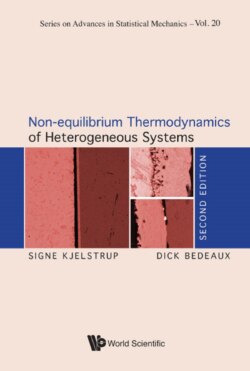Читать книгу Non-equilibrium Thermodynamics of Heterogeneous Systems - Signe Kjelstrup - Страница 12
2.1Simple flux equations
ОглавлениеThe simplest descriptions of heat, mass and charge transports are the equations of Fourier, Fick and Ohm. Fourier’s law expresses the measurable heat flux in terms of the temperature gradient by
| (2.1) |
where λ is the thermal conductivity, T is the absolute temperature and the direction of transport is along the x-axis. Fick’s law gives the flux of one of the components in terms of the gradient of its concentration c:
| (2.2) |
where D is the diffusion coefficient. Similarly, Ohm’s law gives the electric current in terms of the gradient of the electric potential:
| (2.3) |
where κ is the electrical conductivity and ϕ is the electric potential.
In a stationary state, there is no accumulation of internal energy, mass or charge. This means that the heat, molar and electric fluxes are independent of position. The derivatives of the above equations with respect to x are then zero:
| (2.4) | |
| (2.5) | |
| (2.6) |
These equations can be used to calculate the temperature, concentration and electric potential as a function of the position, when their values on the boundaries of the system and λ, D and κ are known. Such a calculation is illustrated by the following exercise.
Exercise 2.1.1.Calculate the temperature as a function of position between two walls at a distance of 10 cm which are kept at constant temperatures of 5°C and 25°C, assuming that the thermal conductivity is constant.
•Solution: According to Eq. (2.4), d2T/dx2 = 0. The general solution of this equation is T(x) = a + bx. The constants a and b follow from the boundary condition. We have T(0) = 5°C and T(10) = 25°C. It follows that T(x) = (5 + 2x)°C.
Equations (2.1)–(2.3) describe a pure degradation of thermal, chemical and electrical energy. In reality, there is also conversion between the energy forms. For an efficient exploitation of energy resources, such a conversion is essential. This is captured in non-equilibrium thermodynamics by the so-called coupling coefficients. Mass transport occurs, for instance, not only because dc/dx ≠ 0, but also becaused T/dx ≠ 0 or dϕ/dx ≠ 0.
Chemical and mechanical engineers need theories of transport for increasingly complex systems with gradients in pressure, concentration and temperature. Simple vectorial transport laws have long worked well in engineering, but there is now an increasing effort to be more precise. The books by Taylor and Krishna [72], Kuiken [34] and Cussler [73], which use Maxwell–Stefan’s formulation of the flux equations, are important books in this context. A need for more accurate flux equations in modelling [45, 72] makes non-equilibrium thermodynamics a necessary tool.
